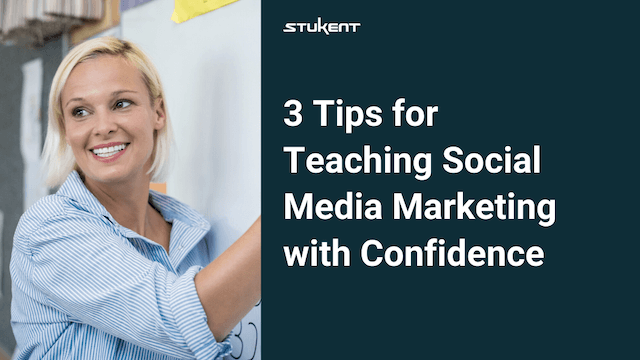Helpful Ideas for High School Instructors
There is a room full of teenagers who have grown up with social media and technology. They know the ins and outs of texting, tweeting, and tagging. They know of influencers, are influencers, and have been following and friending for years. Add to that, btw, they are ppl who understand that FOMO is a BD for a DM or RT.
And you’re supposed to teach them something about social media marketing.
Now what?
That’s what this blog post is all about: confidently teaching social media marketing to high school students. You can do this. Here are some tips on how.
Tip 1: Build on Students’ Prior Knowledge
Teaching social media marketing with confidence involves accepting and embracing that, overall, your students may know more about social media than you do. That doesn’t replace you as the teacher; it positions you to draw on their prior knowledge while helping them learn more.
The reality is that students have grown up with social media. Don’t fight it. Leverage it.
You are in a position to help students pair social media and technological know-how with solid marketing concepts and educational frameworks. You can help them see social media for more than recreational purposes. You can help them understand how businesses use social media in marketing. You can also provide learning experiences for them to get creative with what is still possible through social media marketing.

PERSPECTIVE
Perspective on this approach comes from Radhika Duggal, adjunct instructor at New York University and head of marketing for students at Chase Bank. During her recent Fall 2019 Stukent Digital Summit presentation, Radhika said that teachers are authorities on how businesses worked before the technologies of today and, therefore, can help students see how their familiarity with technology can bring value to companies.
On the topic of students learning about technology’s impact on marketing, Radhika said, “Let the students teach you what they know and acknowledge the fact that they grew up with this, they know this, and be open to learning a thing or two.
“My students have taught me so much, primarily because A, they are experts; B, I’m open to learning — and that’s also a much more robust environment.”
In answering a question following her presentation, Radhika said, “There’s a sense of acknowledging what you do know and there’s a sense of acknowledging openness to what you don’t know, and instead of shutting that down being really open to the students being the ones that lead some of those lessons. Why not highlight their expertise?”
Have students bring into class their understanding and use of social media and technology. Have them speak to the ways they use platforms and draw from their knowledge to help frame class lessons.
Tip 2: Build Your Own Knowledge
There are certainly lots of options for building your social media marketing knowledge. In fact, the challenge may be more in sorting through all of the options to find those that will be of most value to you as an instructor. To help with that, here are five resources for learning about and staying up to date with social media marketing.
BUFFER BLOG
Buffer is in the business of building companies via social media. The company’s “Resources” page is a place to pick up information on what’s going on with social media marketing, including tips on how to use multiple platforms.
HOOTSUITE BLOG
Hootsuite offers social media creation and tracking services and has a large volume of content available online. Check out the Hootsuite blog for lots of information on social media marketing.

SOCIAL MEDIA EXAMINER
The company’s website states, “Our mission is to help you navigate the constantly changing social media jungle.” Look at the “Articles” menu on Social Media Examiner’s website to see some of the content available from this source.
SPROUT SOCIAL BLOG
Sprout Social provides businesses social media tools. The company, which started in 2010, hosts a blog that can be used to boost your social media marketing knowledge.
QUICKSPROUT
Quicksprout provides information on website use and marketing in the digital space. You can also find content on blogging and ecommerce. The company has compiled lists of top resources for a variety of web and digital topics.
INITIAL AND ONGOING ENRICHMENT
The resources included here can be beneficial as you begin establishing a more solid footing in social media marketing. But regularly checking these resources going forward can be helpful, too. Checking these sites can be part of your ongoing homework as you keep up to date with industry announcements, platform changes, and marketing approaches.
Tip 3: Build from Solid Courseware
Building your social media marketing knowledge base can help you feel more comfortable in class, but there is still the responsibility of providing instruction. What will the students learn? What will they have to show for their experience in class? Enter the courseware component — having solid educational resources is a foundational component for building a successful class.
Stukent’s “Marketing Strategies” digital text and Mimic Social simulation is a courseware package that gives students opportunities to learn about and experience how marketing takes place on various social media platforms. The textbook introduces social media for business use and explores marketing on a variety of social media platforms. The simulation takes students through rounds of social media marketing and presents concepts such as targeting, measuring key performance indicators, and ad budgeting.
The courseware is updated to keep up with changes in social media and comes with assignment ideas, system-graded quizzes, lesson plans, and more.
You can learn more about the “Marketing Strategies” and Mimic Social bundle by signing up for a free demonstration of the courseware.
Looking Ahead
These three tips can help high school students learn how to leverage social media in successful marketing and help high school teachers build a successful semester — a win/win that instructors can feel confident about.






